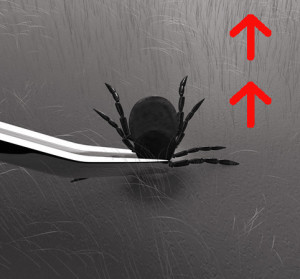Finding a tick attached to yourself or a loved one can be a very freaky experience; Don’t panic though if you find yourself or someone you love in this situation, when your done reading this article you will know exactly what to do. It is also important not to panic because most ticks take between 36 to 48 hours to successfully transmit the dangerous diseases they carry. The fact that removing the tick in a timely safe fashion is so important to your health when dealing with tick bites, makes understanding the information in this article that much more important.
The best removal method for dealing with ticks involves using a set of tweezers to grab the tick. Obviously this is the most common method for removing ticks, but it is also very effective. Multiple organizations endorse using tweezers for tick removal like the Center for Disease Control, The Human Society and the ASPCA a pet organization. If you use the tweezer method correctly this is the safest easiest way to remove a tick, follow these simple steps to safely, and easily remove a tick.
- Locate the area where the tick has attached itself to the host, and then gently pull back any hair from around the area making sure you have a clear path for the removal.
- Examine the tick you are about to remove find the head of the tick, and grasp it with your tweezers. Make sure that you grip the tick as close to the skin as possible with fine tipped tweezers; while gently squeezing. You want to make sure not to just grab the tick’s body, because this can increase the chance of the tick’s blood causing an infection in the host.
- Pull straight outward in a smooth motion until the pressure removes the head of the tick from the host. It is important to not twist or wiggle the tick as it is being removed as this might tear its head of leaving pieces of itself lodged in the host’s skin.
- After the tick has been removed make sure that you thoroughly clean the area in which the bite occurred. Using soap and water to clean the area is fine, but rubbing alcohol or iodine scrub will also do the job.
- To dispose of the tick make sure that your flush it down the toilet in a tightly wrapped tissue. Try not to crush the ticks, because this only helps spread their diseases blood around and make it possible for them still to contaminate things. Once the tick has been removed wrap it in tissue and throw it immediately into the toilet, and flush.
- If after the tick removal you develop a fever or a rash within a couple days to several weeks make sure to contact your doctor. Tick bites can be very serious so experiencing any of these side effects after a tick bite should be properly handled by a doctor.
Make sure that you do not do the following things when removing a tick from a host. The CDC recommends avoiding urban myths that you can suffocate the tick with petroleum jelly or nail polish; these methods simply do not work. You should also not try and burn the tick with matches or other sources of heat so that it detaches; stick with the method outlined in this article.
If you or someone you know is dealing with ticks or other pests in the great Boston area call Johnny B’s Pest Control today. Let our dedicated team of professionals protect your home, or business from pests today. We have been family owned and operated serving the great Boston area for over 30 years. Contact us today to see just how Johnny B’s can help protect you or your business from pests!
Source
Stay up to date with Johnny B’s Social Media Pages!


